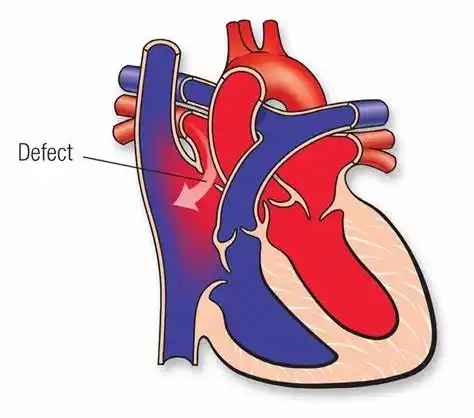Congenital Heart Defects - ASD
Understanding Atrial Septal Defect (ASD)

What is an Atrial Septal Defect (ASD)?
An Atrial Septal Defect (ASD) is a congenital heart defect characterized by a hole in the atrial septum, the wall that separates the two upper chambers (atria) of the heart. This opening allows oxygen-rich blood from the left atrium to mix with oxygen-poor blood in the right atrium, potentially leading to increased blood flow to the lungs and strain on the heart over time.
Key Features of ASD
- Congenital condition, present from birth
- May range in size from small (asymptomatic) to large (symptomatic)
- Can increase blood flow to the lungs and cause heart enlargement
- May lead to complications like pulmonary hypertension or heart failure if untreated
Symptoms of ASD
Symptoms of ASD depend on the size of the defect and may include:
- Shortness of breath, especially during exercise
- Fatigue and reduced stamina
- Heart murmur, detected during a routine check-up
- Frequent respiratory infections
- Swelling in the legs, feet, or abdomen (in severe cases)
- Stroke or blood clots in adults with untreated ASD
Causes and Risk Factors
ASD occurs during fetal development, when the atrial septum fails to close properly. Risk factors include:
- Genetic Factors: Family history of congenital heart defects
- Chromosomal Abnormalities: Conditions like Down syndrome
- Environmental Factors: Exposure to certain medications, infections, or substances during pregnancy
How is ASD Diagnosed and Treated?
Diagnosis involves imaging tests to confirm the presence and size of the defect:
- Echocardiogram: Primary imaging tool to visualize the defect
- Electrocardiogram (ECG): Detects electrical abnormalities caused by the defect
- Cardiac MRI or CT: Provides detailed imaging for complex cases
- Cardiac Catheterization: Measures pressures and oxygen levels in the heart chambers
Treatment options depend on the size and symptoms of the defect:
- Observation: Small, asymptomatic ASDs may close on their own and require only monitoring.
- Catheter-Based Closure: A minimally invasive procedure using a device to seal the defect.
- Surgical Repair: Open-heart surgery to close large or complex ASDs.
- Medications: To manage symptoms like irregular heart rhythms or prevent complications.
Risks and Potential Complications
Untreated ASD can lead to complications, including:
- Pulmonary hypertension (high blood pressure in the lungs)
- Heart failure from prolonged strain on the heart
- Stroke or blood clots due to abnormal blood flow
- Irregular heart rhythms (arrhythmias)
- Eisenmenger syndrome in severe, long-standing cases
Recovery and Long-Term Management
Recovery after ASD treatment depends on the method used. Key steps include:
- Monitoring for complications and ensuring the defect remains closed
- Resuming normal activities gradually under medical guidance
- Attending regular follow-up appointments for heart health evaluation
- Adopting a heart-healthy lifestyle, including proper diet and exercise
With appropriate treatment, most patients with ASD can lead normal, active lives without long-term complications.